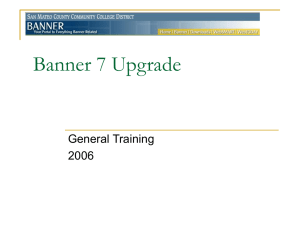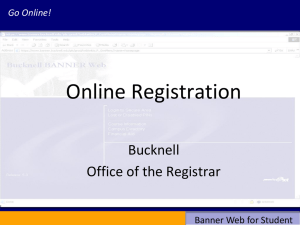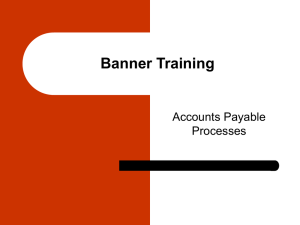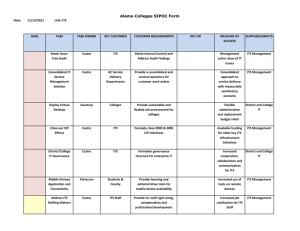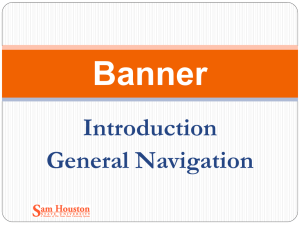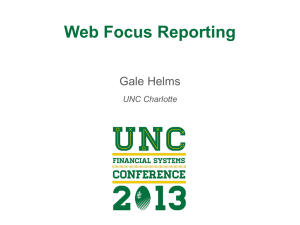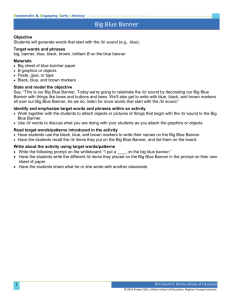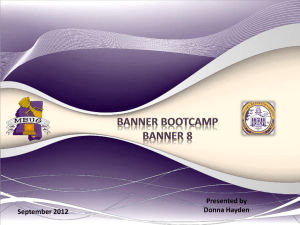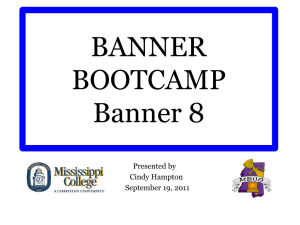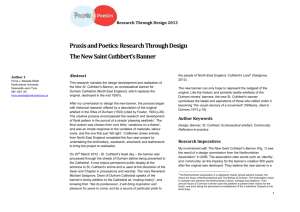Position Budgeting
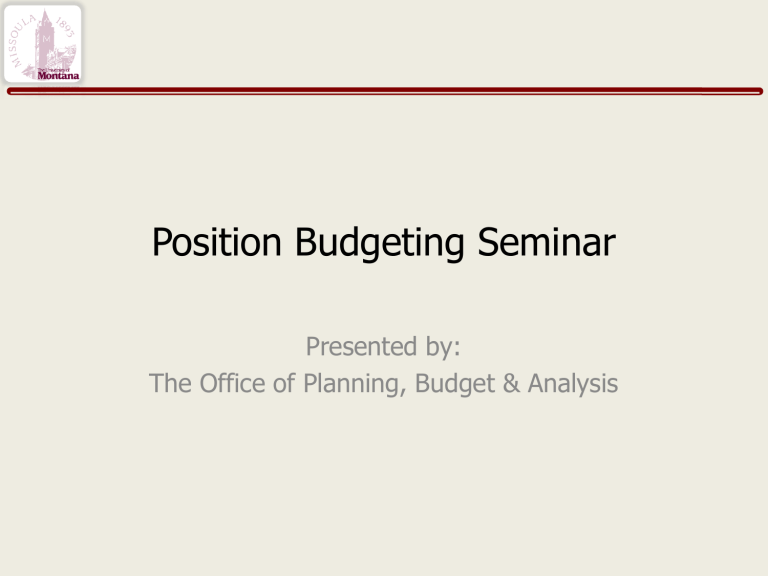
Position Budgeting Seminar
Presented by:
The Office of Planning, Budget & Analysis
Learning Objectives
At the conclusion of this lesson you will be able to:
• describe the fundamental budget practices for an academic environment
• identify the key concepts and methodology to develop a personnel budget
• understand and adjust the variables to model a fully funded position
• differentiate between centrally funded benefits and department-funded benefits
• utilize the financial tools (Banner/UMDW) to analyze the budget status of a position
Position Budgeting
• Definition: Budget for a specific position not a specific person
– Banner as a system is built on Organizations
– Each Organization has Positions as part of the team
– Individuals are placed into the positions
• Know your funding streams before you hire!
Why Position Budgeting
(1 of 5)
Equipment and
Capital
2%
Transfers
2%
Operating Costs
11%
Scholarships and
Fellowships
8%
77%
Benefits
18%
General Funds – Uses
Salaries
59%
Why Position Budgeting
(2 of 5)
Equipment and
Capital
1,656,958
3%
Scholarships and
Fellowships
1,361,450
3%
Designated Funds – Uses
Transfers
4,633,655
10%
33%
Salaries
$11,591,450
25%
Operating Costs
23,754,997
51%
Benefits
3,947,901
8%
Why Position Budgeting
(3 of 5)
Equipment and
Capital
177,365
0.4%
Auxiliary Funds – Uses
Transfers
7,598,225
16.4%
46%
Operating Costs
17,468,256
37.6%
Salaries
$16,224,017
34.9%
Benefits
4,974,924
10.7%
Why Position Budgeting
(4 of 5)
Annual Health Insurance Costs
$8,796
$5,000
$4,000
$3,000
$2,000
$1,000
$9,000
$8,000
$7,000
$6,000
$5,520
$-
2005 2006 2007
46%
2008 2009 2010 2011
Why Position Budgeting
(5 of 5)
• Salaries/Wages & Benefits – University’s #1 expense
– General Funds – $109,135,744
– Designated Funds– $ 14,539,351
– Auxiliary Funds – $ 21,196,941
– Restricted Funds – $ 43,623,931
– Plant Funds – $ 630,000
FY10 Budget - $189,425,967
• Health Ins-FY05 was $5,520/yr in FY11 will be $8,796/yr
• Position Budgets versus Account Code Budgets
– Using Banner as intended
– UM Data Warehouse (UMDW) tools
The Academic Environment
(1 of 5)
• Employee Classifications
– Faculty
• Tenured, Tenure Track, Adjunct…
• Fiscal Year, Academic Year, Merits, Markets and Extra Comp…
– Research Faculty, Assistants and Staff
– Contract Administrators/Contract Professionals
• On-going, Letter of Appointment, Temporary…
– Classified Staff
• Union, Exempt, High Risk, Low Risk, Temporary…
• Longevity, Career Ladders, Lump Sum Bonuses, Overtime…
– Students
• Graduate Teaching Assistants (GTA), Graduate Research
Assistants (GRA), Non-Work Study, Work Study (Federal or
State), Full Time, Less than 6 Credit Hours…
– FTE, Pay Plans, Strategic Pay Increases, Stipends, Pooled
Positions, Termination Pay…
The Academic Environment
(2 of 5)
• Temporary Employees
– Pooled Positions
– Single Positions
– Duration of Employment
– Obligation to Pay Benefits
• Health Insurance
• Retirement Plans
• Accrue Annual Vacation and Sick Time Hours
The Academic Environment
(3 of 5)
• Possible Funding Streams
– General Funds
• Base Budget
• One Time Only (OTO)
– Designated Funds
– Auxiliary Funds
– Restricted Funds
• Research
• Gifts
– Plant Funds
The Academic Environment
(4 of 5)
• Program Integrity
– Instruction
– Research
– Public Service
– Academic Support
– Student Services
– Institutional Support
– Plant and Maintenance
– Scholarships
The Academic Environment
(5 of 5)
FY10 Budgeted General Funds by Program
O&M Plant
16,299,725
12%
Institutional
Support
14,858,171
10%
Scholarships &
Fellowships
11,723,741
8%
Student Services
9,038,755
6%
Academic Support
17,920,452
13%
Instruction
69,297,093
49%
Public Service
1,406,701
1%
Research
1,703,790
1%
Model a Fully Funded Position
• Remember a Model helps to Answer “What if?”
• Best Guess based on Past Practice, Facts & Assumptions
• What is the Most Likely versus Worst Case
– Known funding streams or “soft” money
– For SPABA funds intentionally setting aside a reserve just in case
Model a Personnel Budget
(1 of 4)
Dean
Chair
Associate
Dean
Professor Adjunct Pool
Administrative
Associate
Benefits & Other Payroll Expenses
• What are Centrally Funded Benefits?
– How are they calculated?
– The dilemma of base funding vs. OTO funding
• What are Department (Designated/Auxiliary/Restricted)
Funded Benefits?
– How are they calculated?
Model a Personnel Budget
(2 of 4)
Model a Personnel Budget
(3 of 4)
Model a Personnel Budget
(4 of 4)
Break!
Using UMDW/Banner
• Individual Positions Numbers
– Organizations have assigned series
• Pooled Position Numbers
– First half of the number indicates type of pool
– Second half of the number indicates in which department
Pooled Position Numbering
Newer pooled position structure that was implemented in
FY09
UMDW
Use the parameters 61, 62, and 63 in account type field to exclude benefits expense
UMDW Employee Budget/Actual
Banner
(1 of 9)
Banner
(2 of 9)
Banner
(3 of 9)
Banner
(4 of 9)
Comments are added for each budget adjustment within this screen, including date, amount of adjustment, index code to/from, and short explanation
Banner
(5 of 9)
Banner
(6 of 9)
Banner
(7 of 9)
Banner
(8 of 9)
Banner
(9 of 9)
UMDW Employee Budget/Actual
RBC – General Funds
(1 of 2)
RBC – General Funds
(2 of 2)
RBC – Des/Aux Funds
(1 of 2)
RBC – Des/Aux Funds
(2 of 2)
Position Budgets – Des/Aux
(1 of 2)
Position Budgets – Des/Aux
(2 of 2)
Position Budgets – General Funds
Review
• describe the fundamental budget practices for an academic environment
• identify the key concepts and methodology to develop a personnel budget
• understand and adjust the variables to model a fully funded position
• differentiate between centrally funded benefits and department-funded benefits
• utilize the financial tools (Banner/UMDW) to analyze the budget status of a position
Discussion
Future Events
• Position Budget Training
- Thursday, January 28 th
• Designated and Auxiliary Fund Operating Plans Training
– Thursday, February 4 th
• Build Designated/Auxiliary Budgets
- Thursday, February 11 th or
- Thursday, March 11 th
• General Funds Budget Training
- Wednesday, April 21 st or
- Thursday, April 22 nd

